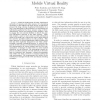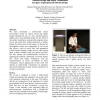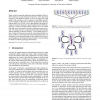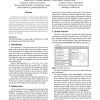CIA
2001
Springer
14 years 4 months ago
2001
Springer
User-to-User Communication within Internet-based 3D Virtual Environments is usually difficult mainly due to the trade-off between the capability and the complexity of the interface...
VR
2002
IEEE
14 years 4 months ago
2002
IEEE
In virtual environments, perceived egocentric distances are consistently underestimated when compared to the same distance judgments in the real world. The research presented in t...
ICRA
2002
IEEE
14 years 4 months ago
2002
IEEE
— With the deployment of large, distributed networks of cameras and other sensors, it is becoming necessary to also address the issue of how to effectively present the large vol...
HAPTICS
2002
IEEE
14 years 4 months ago
2002
IEEE
We have developed a multi-modal virtual environment set-up by fusing visual and haptic images through the use of a new autostereoscopic display and a force-feedback haptic device....
VRST
2003
ACM
14 years 4 months ago
2003
ACM
Virtual environments (VEs) allow users to experience and interact with a rich sensory environment, but most virtual worlds contain only sensory information similar to that which w...
VRML
2003
ACM
14 years 4 months ago
2003
ACM
Multi-user virtual environment (MUVE) systems integrate the technologies of virtual reality and distributed system to allow users to interact with each other in a realistic virtua...
VRML
2003
ACM
14 years 4 months ago
2003
ACM
We consider the possibility of automatically modifying the user’s viewpoint orientation for the purpose of enhancing the navigation experience. We concentrate on outdoor virtual...
SI3D
2003
ACM
14 years 4 months ago
2003
ACM
Many virtual environments and games must be populated with synthetic characters to create the desired experience. These characters must move with sufficient realism, so as not to...
VR
2003
IEEE
14 years 4 months ago
2003
IEEE
In this paper we present a distributed scene graph architecture for use in the blue-c, a novel collaborative immersive virtual environment. We extend the widely used OpenGL Perfor...
CW
2003
IEEE
14 years 4 months ago
2003
IEEE
The MOVES Institute’s mission is research, application, and education in the grand challenges of modeling, virtual environments, and simulation. Specialties are 3D visual simula...





